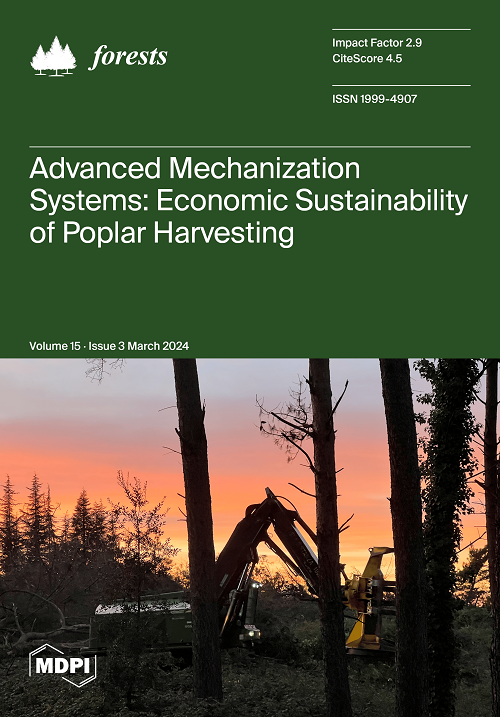Improved Tree Segmentation Algorithm Based on Backpack-LiDAR Point Cloud
IF 2.5
2区 农林科学
Q1 FORESTRY
引用次数: 0
Abstract
For extracting tree structural data from LiDAR point clouds, individual tree segmentation is of great significance. Most individual tree segmentation algorithms miss segmentation and misrecognition, requiring manual post-processing. This study utilized a hierarchical approach known as segmentation based on hierarchical strategy (SHS) to improve individual tree segmentation. The tree point cloud was divided into the trunk layer and the canopy layer to carry out trunk detection and canopy segmentation, respectively. The effectiveness of SHS was evaluated on three mixed broadleaf forest plots. The segmentation efficacy of SHS was evaluated on three mixed broadleaf forest plots and compared with the point cloud segmentation algorithm (PCS) and the comparative shortest-path algorithm (CSP). In the three plots, SHS correctly identified all the trunk portion, had a recall (r) of 1, 0.98, and 1, a precision (p) of 1, and an overall segmentation rate (F) of 1, 0.99, and 1. CSP and PCS are less accurate than SHS. In terms of overall plots, SHS had 10%–15% higher F-scores than PCS and CSP. SHS extracted crown diameters with R2s of 0.91, 0.93, and 0.89 and RMSEs of 0.24 m, 0.23 m, and 0.30 m, outperforming CSP and PCS. Afterwards, we evaluate the three algorithms’ findings, examine the SHS algorithm’s parameters and constraints, and discuss the future directions of this research. This work offers an enhanced SHS that improves upon earlier research, addressing missed segmentation and misrecognition issues. It improves segmentation accuracy, individual tree segmentation, and provides both theoretical and data support for the LiDAR application in forest detection.基于背包式激光雷达点云的改进型树形分割算法
要从激光雷达点云中提取树木结构数据,单棵树木的分割具有重要意义。大多数单棵树分割算法会出现分割遗漏和识别错误,需要人工进行后处理。本研究利用一种被称为基于分层策略(SHS)的分层方法来改进单棵树的分割。树木点云被分为树干层和树冠层,分别进行树干检测和树冠分割。在三个阔叶混交林地块上评估了分层策略的有效性。在三个混交阔叶林地块上评估了 SHS 的分割效果,并与点云分割算法(PCS)和比较最短路径算法(CSP)进行了比较。在这三个地块中,SHS 能正确识别所有树干部分,召回率(r)分别为 1、0.98 和 1,精确率(p)为 1,总体分割率(F)分别为 1、0.99 和 1。在总体图谱方面,SHS 的 F 分数比 PCS 和 CSP 高 10%-15%。SHS 提取树冠直径的 R2 分别为 0.91、0.93 和 0.89,RMSE 分别为 0.24 米、0.23 米和 0.30 米,优于 CSP 和 PCS。随后,我们评估了三种算法的结果,研究了 SHS 算法的参数和约束条件,并讨论了本研究的未来方向。这项研究在早期研究的基础上改进了 SHS 算法,解决了分割遗漏和识别错误的问题。它提高了分割精度和单棵树木的分割,并为激光雷达在森林检测中的应用提供了理论和数据支持。
本文章由计算机程序翻译,如有差异,请以英文原文为准。
求助全文
约1分钟内获得全文
求助全文
来源期刊

Forests
FORESTRY-
CiteScore
4.40
自引率
17.20%
发文量
1823
审稿时长
19.02 days
期刊介绍:
Forests (ISSN 1999-4907) is an international and cross-disciplinary scholarly journal of forestry and forest ecology. It publishes research papers, short communications and review papers. There is no restriction on the length of the papers. Our aim is to encourage scientists to publish their experimental and theoretical research in as much detail as possible. Full experimental and/or methodical details must be provided for research articles.
 求助内容:
求助内容: 应助结果提醒方式:
应助结果提醒方式:


